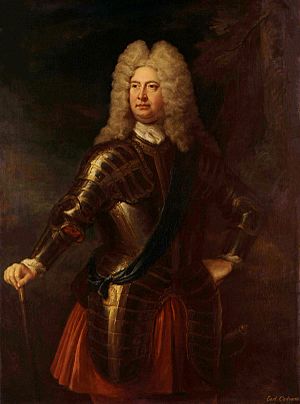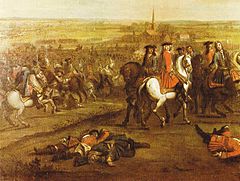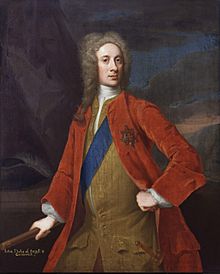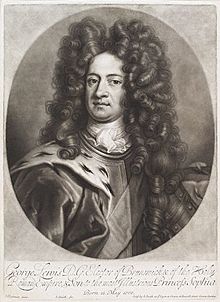William Cadogan, 1st Earl Cadogan facts for kids
Quick facts for kids
|
|
|---|---|

William Cadogan (c.1671–1726) by Louis Laguerre
|
|
| Born | 1671 Liscarton, County Meath, Ireland |
| Died | 17 July 1726 Kensington Gravel Pits, London |
| Buried | |
| Allegiance | |
| Service/ |
|
| Years of service | 1689–1716 |
| Rank | Master-General of the Ordnance 1722–1725 |
| Unit | Colonel, 1st Regiment of Foot Guards 1722–1726 |
| Commands held | |
| Battles/wars | Williamite War in Ireland Battle of the Boyne Siege of Cork Limerick Nine Years War Namur 1695 War of the Spanish Succession Schellenberg Blenheim Malplaquet Arras 1715 Jacobite Rebellion |
| Awards | Order of the Thistle 1717 |
William Cadogan (around 1671–1726) was an important British Army officer. He was born in Ireland and started his military career in 1689 during the Williamite War in Ireland. He finished his service helping to stop the Jacobite Rebellion in 1715.
Cadogan was a close friend and trusted helper of the famous general, the Duke of Marlborough. He also worked as a diplomat (someone who handles relations between countries) and was a Whig politician. He served in the British Parliament from 1705 until 1716.
In 1716, he became a noble, known as Baron Cadogan. He strongly supported the Hanoverian Succession, which meant the British throne would go to the Hanoverian family. After Marlborough died in 1722, Cadogan took over his role as Master-General of the Ordnance, a very senior army position.
Contents
Early Life and Education
William Cadogan was born in Ireland around 1671. His father, Henry Cadogan, was a lawyer, and his mother was Bridget Waller. His family were Irish Protestants with Welsh roots. William's grandfather had been an officer in Oliver Cromwell's army.
William was one of five children. His family owned land in County Meath, Ireland. His father was a local official and also bought property in County Limerick.
When he was ten, William went to Westminster School in England. His father wanted him to become a lawyer, so in 1687, he started studying at Trinity College, Dublin. William grew into a tall and strong young man.
Military Service in Ireland
Around the time William was studying, a big change happened in England called the Glorious Revolution. The Protestant William of Orange took the throne from the Catholic James II. In Ireland, most of the army stayed loyal to James.

However, Protestants in Ireland supported William. William Cadogan joined the Protestant "Army of the North" as a Cornet (a junior officer) in the cavalry.
In 1689, he helped defend Enniskillen, one of the few places that held out against James's army. After Derry and Enniskillen were saved, Cadogan continued to fight with William's troops in the Williamite War in Ireland.
He was at Dundalk Camp in 1689, where many soldiers got sick. The next year, he fought in the Battle of the Boyne. This was a major victory where William III himself led his forces, leading to the capture of Dublin.
Later that year, Cadogan took part in the Siege of Cork. This was where he first met and served with Marlborough, who was an Earl at the time. Even as a junior officer, Cadogan's actions impressed Marlborough.
After the important victory at the Siege of Limerick in 1691, Cadogan decided to become a professional soldier. He stayed in Ireland for three more years. In 1694, he bought a Captaincy (a higher rank) in a regiment stationed in Flanders. This was part of the Nine Years' War against France.
In 1695, he fought in the Siege of Namur, an important victory for the Grand Alliance. After the war ended with the Peace of Ryswick, he returned to Ireland. In 1698, he became a major in the Inniskilling Dragoons.
War of the Spanish Succession
Joining Marlborough's Staff
In June 1701, Cadogan was chosen to be Quartermaster General for Marlborough. Marlborough was put in charge of the British forces in the Low Countries. Marlborough was impressed by Cadogan's organizing skills and bravery from the Siege of Cork. He had Cadogan promoted to Colonel, even though other officers had more experience.
In July 1701, Cadogan went with Marlborough and King William to Holland. Britain had not officially joined the war yet, but they were getting ready. Cadogan learned to speak Dutch and already knew French. In Amsterdam, he met and fell in love with a Dutch heiress named Margaretta Munter. They married two years later.
The war started in 1702 after Queen Anne became queen. Cadogan became Marlborough's chief of staff. He was a trusted helper, working closely with Marlborough's brother Charles Churchill and others. He also worked with the Dutch representative, Anthonie Heinsius.
Cadogan quickly showed he was good at logistics (moving and supplying troops) and managing things. He also led the army's intelligence operations, gathering secret information.
In early 1704, while traveling back to England with important papers, his ship was attacked by a French Privateer (a private ship allowed to attack enemy ships). Fearing his secret papers would be captured, he threw them into the sea. Luckily, his ship escaped safely. In London, he met with Queen Anne.
Key Battles: Blenheim and Ramillies
During the 1704 campaign, Cadogan was one of the few who knew Marlborough's secret plan to march from the Spanish Netherlands to the Danube River. He played a big part in organizing this long march. He wrote, "This march has hardly left me time to eat or sleep."
He fought in the battles of Schellenberg and Blenheim. Soon after, he was promoted to brigadier general and became Marlborough's chief of staff.

At the Battle of Ramillies in 1706, Cadogan led the army's scouting group that found the French army. He also acted as a messenger for Marlborough during the battle. He helped move British infantry to attack the French center.
In August 1706, Cadogan was captured while scouting enemy positions and taken prisoner to Tournai. Marlborough was very worried, saying, "I shall not be quiet till I know his fate." Within two days, an exchange was arranged. Cadogan was swapped for a French General captured at Ramillies.
At the Oudenarde, he commanded the allied advance guard, which set up crossings over the River Scheldt. In 1706, he was promoted to major general. He commanded the forces that broke through the French left side towards the end of the battle.
Later Campaigns
In 1709, he was promoted to lieutenant general. He fought at the Malplaquet. He was wounded in the neck during the siege of Mons, but he recovered quickly.
At the end of 1709, Cadogan was made a Lieutenant of the Tower of London. During the breaking of the "lines of Ne Plus Ultra" (a strong French defense line), he again led the allied advance guard. He set up a bridgehead before Marlborough arrived with the main army.
Exile and Return
After Marlborough was removed from his positions in late 1711, Cadogan stayed with the army. However, he refused to return to Britain when the country pulled out of the war in 1712. He chose to go into voluntary exile with Marlborough. Because of this, he lost his military rank and positions.
Cadogan strongly disagreed with the Treaty of Utrecht, which ended the war. He sided with the Whig party, who wanted "No Peace Without Spain."
During Marlborough's exile, Cadogan often acted as a go-between, keeping Marlborough connected to Britain. When the Hanoverian King George I became king in 1714, he gave Cadogan back his military roles. Marlborough was made commander-in-chief again, but Cadogan took on much of his workload as his deputy.
Cadogan was also rewarded with the job of Ambassador to the Dutch Republic. His task was to fix the relationship with Britain's former ally, which had been damaged by Britain's sudden exit from the war. Cadogan helped negotiate a new treaty, which was finished the next year.
Stopping the Jacobite Rebellion

In 1715, Cadogan replaced the Duke of Argyll in command of the army fighting a Jacobite Rebellion. This rebellion started in the Scottish Highlands in autumn 1715. The Duke of Argyll, as the senior Scottish commander, first tried to stop the Jacobites from Stirling Castle.
In November, Argyll fought an intense but undecided battle against the Jacobites at the Battle of Sherrifmuir. After this, London decided Argyll was not fully committed to the Hanoverian cause.
Marlborough then sent Cadogan north to provide stronger leadership. Cadogan brought 6,000 Dutch troops with him, whose transport to Britain he had organized. While Cadogan was away from The Hague, another diplomat, Horatio Walpole, took over his duties there.
Cadogan found that Argyll was still hesitant to move against the Jacobites because of the winter weather. This continued even after James Stuart, who claimed to be King, arrived near Aberdeen in December.
Argyll and Cadogan worked together for a while, but Argyll no longer had the government's trust. Cadogan improved the army's supply lines, personally scouted areas, and organized the advance on the rebel capital at Perth. Instead of facing a siege, the Jacobites retreated to Dundee. In February 1716, James gave up trying to lead the rebellion in Scotland and sailed to Europe.
Soon after, Argyll resigned and went to London, giving total command to Cadogan. Argyll was later removed from all his military and political roles, with claims that he had Jacobite sympathies. Cadogan's job was to continue military operations across northern Scotland, forcing the leading Clan chiefs to surrender.
In April, Cadogan declared the rebellion over. He returned to London the next month. Marlborough helped him get a peerage (a noble title) as a reward for his efforts during the campaign.
Later Life and Family

Cadogan was a Whig Member of Parliament for Woodstock from 1705 to 1716. On June 21, 1716, he was made Baron Cadogan of Reading. He had recently bought Caversham Park near that town. He also became a Knight of the Thistle and, the next year, a member of the Privy Council.
On May 8, 1718, King George I made him the 1st Earl Cadogan. He also became Viscount Caversham. In later years, he served as Master of the Robes (1714–1726) and governor of the Isle of Wight (1715–1726).
When the Duke of Marlborough died in 1722, Cadogan walked at the front of his funeral procession. He took over Marlborough's role as Master-General of the Ordnance (1722–1725). However, he had lost much political influence several years before his death on July 17, 1726.
William Cadogan married Margaret Cecilia Munter in April 1704. They had two daughters: Sarah (born 1705), who married the 2nd Duke of Richmond, and Margaret (born 1707). Since he had no sons, his earldom ended when he died. His younger brother Charles inherited the barony, passing it down through his own son.



